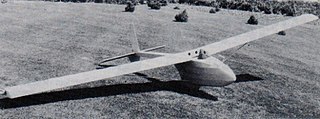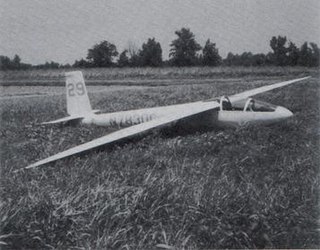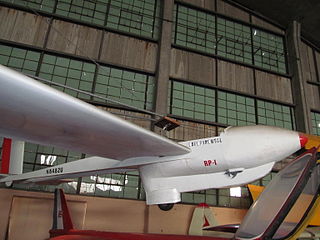Related Research Articles

The Hall Vector 1 is an American high-wing, ultralight glider that was designed by Stan Hall for serious cross-country flights.

The Bikle T-6 is an American, mid-wing, single seat, glider designed by Paul Bikle and based upon the design of the Schreder HP-14. Even though only one T-6 was built it is noted as the most tested and studied glider with complete data published. It has been used extensively as a comparative reference glider for evaluating other designs during in-flight comparisons.
The Gehrlein GP-1 is an American mid-wing, single seat FAI Standard Class glider that was designed by Jay and Rod Gehrlein and first flown in July 1968.
The Lamson L-106 Alcor is an American, high-wing, experimental, pressurized research glider that was designed and built by Bob Lamson. The Alcor was the first pressurized sailplane ever built.
The Parker RP9 T-Bird is an American, high-wing, T-tailed, single-seat, FAI Open Class glider that was designed and constructed by Ray Parker between 1956 and 1962.

The Prue 160 was an American mid-wing, V-tailed, single-seat glider that was designed and built by Irving Prue in 1945.

The Midwest MU-1 was an American single-seat, high-wing, strut-braced utility glider that was designed by Arthur B. Schultz in the 1930s.

The Tweed GT-1 is an American high-wing, FAI Open Class single seat glider that was designed by George Tweed Jr.
The Whigham GW-5 is an American mid-wing, single seat, FAI Standard Class glider that was designed and constructed by Gene Whigham, a retired flight test engineer for Convair.
The Whigham GW-7 is an American mid-wing, single-seat, 15 metre class glider that was designed and constructed by Gene Whigham, a retired Convair flight test engineer.
The Maupin Windrose is an American high-wing, single-seat glider and motor glider that was designed by Jim Maupin for the Sailplane Homebuilders Association Design Contest.
The Haufe Buzzer 2 is an American high-wing, strut-braced single-seat motor glider that was designed and constructed by Walter Haufe.
The Haufe HA-G-1 Buggie is an American high-wing, strut-braced, single-seat, glider that was designed and constructed by Bruno Haufe and Klaus Hill, first flying in 1967.
The Celair GA-1 Celstar is a South African mid-wing, single-seat, aerobatic glider that was designed by Pieter Celliers and produced by his company, Celair (Pty) Limited.

The Politechnika Warszawska PW-2, also called the PW-2 Gapa, is a Polish lightweight high-wing, strut-braced single-seat, glider that was designed and built at the Warsaw University of Technology and also produced by DWLKK in the early 1990s. Total number of 19 gliders were built, including variant PW-2D bis.
The Farrar V-1 Flying Wing is an American, single-seat, flying wing glider that was designed and constructed by Demetrius F. Farrar Jr. in 1962.
The Farrar LSG-1 Bird Flight Machine is an American, high-wing, V-tailed, single-seat, experimental research glider that was designed and built by Demetrius F. Farrar Jr. in 1969 for exploring aspects of bird flight.

The PZL Krosno KR-03 Puchatek is a Polish mid-wing, T-tailed, two-seats-in-tandem, glider that was designed by Jerzy Krawczyk and Eugeniusz Pelczar and produced by PZL Krosno, first flying in 1985.

The Rensselaer RP-1 is an American low-wing, single-seat, foot-launchable glider that was designed and produced by the Rensselaer Polytechnic Institute of Troy, New York. It first flew in 1980.
The Rensselaer RP-3 is an American mid-wing, T-tailed single-seat, glider that was designed by Brian E. Thompson and produced by the Rensselaer Polytechnic Institute of Troy, New York. It first flew in 1998.
References
- 1 2 3 4 Activate Media (2006). "RP-2 Rensselaer". Archived from the original on September 2, 2012. Retrieved August 24, 2011.
- 1 2 Federal Aviation Administration (August 2011). "Make / Model Inquiry Results" . Retrieved August 24, 2011.
- ↑ Lednicer, David (2010). "The Incomplete Guide to Airfoil Usage" . Retrieved August 24, 2011.